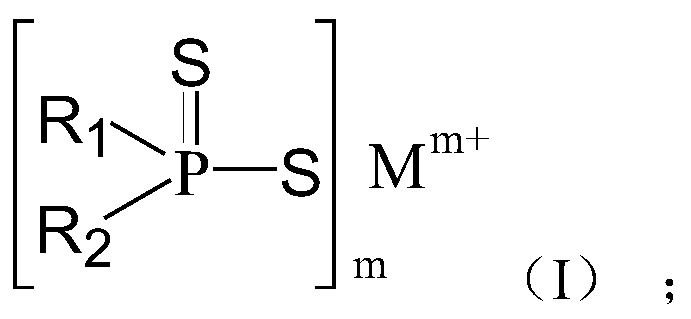No droplet and no water stain based on dialkyl dithiophosphinate flame retardant polyurethane leather composition
A technology of dialkyl dithiophosphinate and polyurethane leather, which is applied in textiles and papermaking, and can solve problems such as poor flame retardancy, stickiness, and incompatibility
- Summary
- Abstract
- Description
- Claims
- Application Information
AI Technical Summary
Problems solved by technology
Method used
Image
Examples
preparation example Construction
[0062] Preparation of flame retardant components
[0063] (1) Preparation of aluminum diisobutyl dithiophosphite
[0064] Prepare respectively 1392g of sodium diisobutyldithiophosphite aqueous solution with a concentration of 20wt% and 228g of an aluminum sulfate solution with a concentration of 30wt%, add 1500g of desalted water in the reactor, and add 75g of a sulfuric acid solution with a concentration of 25wt%, and heat up to 80 ℃, start to add diisobutyl dithiophosphite sodium aqueous solution and aluminum sulfate solution synchronously to the reaction kettle in proportion to obtain diisobutyl dithiophosphite aluminum precipitate, dropwise complete in 2 hours, keep warm for 1 hour, then filtered, washed, and dried to obtain 254g (yield 97%) of diisobutyl aluminum dithiophosphite flame retardant.
[0065] After testing, the initial decomposition temperature of the product is 350°C, and its solubility in water is 0.02%;
[0066] (2) The preparation process of the carbon-f...
Embodiment 1
[0072] Polyurethane leather was prepared and characterized as follows:
[0073] (1) Prepare flame-retardant polyurethane resin composition by following formula:
[0074] Polyurethane resin base system 85%;
[0075] Aluminum Diisobutyldithiophosphite 11%;
[0076] Carbon-forming components 4%;
[0077] Wherein, by weight, the composition of the polyurethane resin base material system is:
[0078]
[0079] (2) Coat the above-mentioned flame retardant polyurethane composition on the polyester warp knitted fabric to form a coating with a thickness of 250 μm, dry and solidify it in a drier at 120°C for 3 minutes, and press it with a cloth binding machine, and heat it at 40°C Aged for 72 hours to obtain flame-retardant synthetic leather.
[0080] (3) Test related performance.
[0081] See Table 1 for the materials and their proportions in the examples, and see Table 1 for the performance test results of the obtained materials.
Embodiment 2
[0083] The implementation process is the same as in Example 1, except that the ratio of diisobutyl aluminum dithiophosphite and carbon-forming components is adjusted, the ratio of diisobutyl aluminum dithiophosphite is increased, and the total amount of the flame retardant system is kept constant. Change. Other materials and proportioning are shown in Table 1, and the obtained material results are shown in Table 1.
PUM
| Property | Measurement | Unit |
|---|---|---|
| decomposition temperature | aaaaa | aaaaa |
| melting point | aaaaa | aaaaa |
| thickness | aaaaa | aaaaa |
Abstract
Description
Claims
Application Information
 Login to View More
Login to View More - Generate Ideas
- Intellectual Property
- Life Sciences
- Materials
- Tech Scout
- Unparalleled Data Quality
- Higher Quality Content
- 60% Fewer Hallucinations
Browse by: Latest US Patents, China's latest patents, Technical Efficacy Thesaurus, Application Domain, Technology Topic, Popular Technical Reports.
© 2025 PatSnap. All rights reserved.Legal|Privacy policy|Modern Slavery Act Transparency Statement|Sitemap|About US| Contact US: help@patsnap.com



